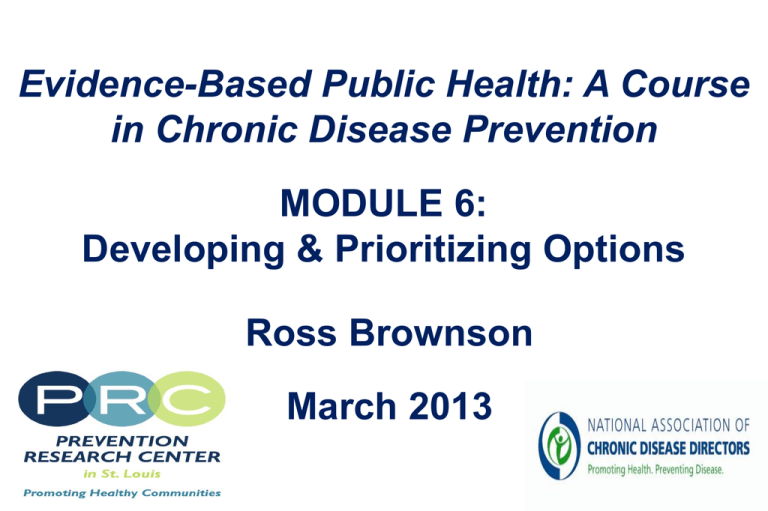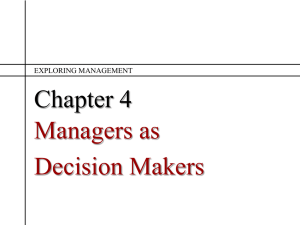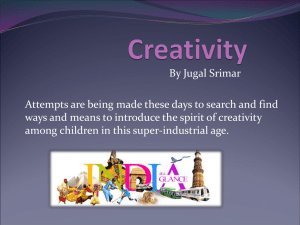Presentation for NC Mtg. on Community based CVD Prevention
advertisement

Evidence-Based Public Health: A Course in Chronic Disease Prevention MODULE 6: Developing & Prioritizing Options Ross Brownson March 2013 Learning Objectives: 1. Identify methods for prioritizing program and policy options (Types 1, 2, and 3). 2. Explore the role of creativity and group processes in developing intervention options. 3. Understand when and how to adapt interventions for different communities, cultures, and settings. Prioritizing • Once options are identified and type 1 issue is set, how should one set types 2 and 3 priorities? Prioritizing There is no “one best way” to set public health priorities. What is essential, however, is that a process or method be adopted that is systematic, objective, and allows for standardized comparison of problems or alternatives that incorporate the scrutiny of science and the realities of the environment. Vilnius & Dandoy, 1990 Prioritization: It’s not easy, but it’s worth it. For every complex problem, there is a solution that is simple, neat, and wrong. H.L. Mencken In the Context of Uncertainty Key elements for effective decision making include: • Acquiring sufficient evidence on all alternatives • Approaching the problem in a rational and systematic fashion • Relying on experience, intuition, and judgment Decision making usually involves some element of risk Policy and Program Planning Options* More Important Less Important More Changeable Highest priority for program focus Low priority except to demonstrate change for political purpose Less Changeable Priority for innovative programs with evaluation essential No intervention program *From: Green and Kreuter. Am J Prev Med 2000;18(1S):7-9 A variation for type 2 evidence More Effective Less Effective More Feasible Highest priority focus Generally low priority Less Feasible Priority for enhancing resources No intervention program Example, Prioritization table: Diabetes prevention in Rio Grande Pueblo communities More important Less important Sustaining community support for healthy living with diabetes Availability of resources for healthy eating and exercise Image of diabetes from one of hopelessness to one that engenders hope Some stories of diabetes reveal poor outcomes, rather than success Food choices at celebrations or feasts More feasible Less feasible History that led to social, environmental, and physiological changes Social, work, and family obligations Ideal body weight Common Elements of Criteria: Prioritizing Public Health Issues at the Community Level • Measure of burden – mortality, morbidity, years of life lost • Quantifying preventability – potential effects of the intervention • Resources – cost of intervention, resources needed to carry out a program or policy Activity: Prioritization Methods …a few examples (NACCHO handout) • Form a group of 4 • Using the NACCHO Handout: – – – – Person 1: Multi-voting Technique Person 2: Strategy Grids Person 3: Nominal Group Technique Person 4: Hanlon Method • Individually, review your assigned option (5 minutes) – You don’t need to become an expert! • Share your example with others in your group (5 minutes each) – What are the highlights? Key Learnings? 12 Regardless of the Method Used • First major stage: Decide upon the criteria • Could use existing framework or a composite of various approaches • Form a team/advisory group • Assemble necessary data • Establish a process for stakeholder input/review • Determine process for revisiting priorities regularly No determination of public health priorities should be reduced solely to numbers; values, social justice, and the political climate all play roles. Brownson et al., 2011 14 Group Process 15 Decision Making with Groups/ Enhancing Creativity • Why make decisions via groups? • Concepts of creativity • Basic processes Decision Making via Groups • Classic decision theory defined rationality from an economic perspective – ie, make decisions in the best economic interest of your organization • Herbert Simon developed concept of behavioral decision theory--bounded rationality – decisions limited by values, unconscious reflexes, skills, habits--beyond only economic criteria Decision Making via Groups In PH, remember concept of social justice “Public health is ultimately and essentially an ethical enterprise committed to the notion that all persons are entitled to protection from hazards and to minimization of risks of death and disability.” Beauchamp (1976) Decision Making via Groups A sound priority-setting process can help generate widespread support for public health issues when it is well documented and endorsed by communities. Healthy People 2010 Toolkit 19 Decision Making In Broader Context • Why use groups for developing options and decision making? – pros – cons Group Option Selection/ Decision Making Advantages Disadvantages More information and knowledge Process takes longer More alternatives generated Indecisiveness/compromises Better acceptance of final decision May not get equal input from all Enhanced communication “Groupthink” may occur in making final decision More accurate decisions generally emerge Creativity in Option Selection • Process of developing original, imaginative, innovative options (something new and unusual) • Creativity is generally good – Trade off between evidence-based approaches and innovation – Creativity in adaptation may be key • We know relatively little about creativity – – – – little overlap with intelligence few gender differences most creative from 30-40 years creative people less susceptible to social influences Creativity in Option Selection • Group/staff processes can enhance creativity • Creative ideas should be rewarded • Employees must have some freedom and autonomy to be creative • Creativity from community members can be essential Group Decision Making • On balance, better alternatives in most situations Techniques for Group Option Selection/Decision Making • Delphi technique • Nominal group technique Techniques for Group Option Selection/Decision Making • Delphi technique – developed by Rand to solicit expert input • systematic refinement/iterative – opinions are combined and averaged – usually more appropriate for broad, long-range issues – judgments provided independently, confidentially – good for spread out advisory committees Techniques for Group Option Selection/Decision Making • Nominal group technique – – – – – develops creative, innovative alternatives quicker, more appropriate for routine issues write down ideas, take turns stating record ideas, discussion limited to clarification open discussion after all alternatives • A key is good facilitator • Example: two most critical obesity-related interventions for improving energy balance in your community – look for multiple information sources Options Applied Across Framework • Starting point for group process can be a literature-based summary • Ecological framework is one useful way to organize information • Group process can then be applied to initial framework Adapting Interventions 29 Local/population adaptation • Scientific evidence is a starting point • Realize that ALL programs need some level of adaptation (reinvention) • Limits of scientific evidence should be noted – Context (culture, local norms, history) is largely lacking in the scientific literature and systematic reviews – Concepts of applicability and transferability • Can it be implemented locally? • Will the intervention be as effective as in the original study? – Work on lifestyle changes that are consistent with history and culture Adaptation • Often a tension between fidelity and reinvention – Fidelity: altering a program from its original design and components may reduce its effectiveness upon replication – Adaptation/reinvention: changes in programs are needed for replication in new settings • Starting (as in Module 2) with a community needs assessment is often useful Fidelity vs Adaptation, Some evidence… • Review of over 500 studies showed a relationship between the level of implementation (fidelity) and program outcomes • However, fidelity was below 100%; some adaptation always occurs and there is some evidence that it improves outcomes Durlak, J. A. & DuPre, E. P. (2008). Implementation matters: A review of research on the influence of implementation on program outcomes and the factors affecting implementation. Am J Comm Psych, 41, 327-350 Considerations for Adaptation Green, Yellow & Red Light Adaptations Provides guidance on whether a particular adaptation is … …safe (green) …should be made cautiously (yellow) …should be avoided (red) Things That Can Probably Be Modified • • • • • • • • Names of health care centers or systems Pictures of people and places and quotes Hard-to-read words that affect reading level Wording to be appropriate to audience Ways to recruit your audience Incentives for participation Timeline (based on adaptation guides) Cultural preferences based on population NOTE: Some of these adaptations may require formative work. Things That Can Probably Be Modified: Proceed with Caution • Substituting activities • Adding activities to address other risk factors or behaviors • Changing the order of the curriculum or steps (sequence) Things That Cannot Be Modified • The health communication model or theory • The health topic/behavior • Deleting core elements or whole sections of the program • Reduction of program – Timeline – Dosage (e.g., activities, time/ session) • Putting in strategies that detract from the core elements Implementation Guides Can be Useful Summary • Priority setting is an art and a science – Not one “correct” answer • Classic decision theory suggests complete information = rational behavior – Dictated in part by the time available for a decision • Priorities should not be set on quantitative data alone – Try out a prioritization process on small scale • Be creative in adaptation/reinvention (group processes can be useful) Acknowledgement Parts were adapted from: CDC Division of Reproductive Health; Lezin, N., L. A. Rolleri, M. M. Wilson, T. R. Fuller, R. Firpo-Triplett, and R. P. Barth. 2010. Reducing the Risk Adaptation Kit. Santa Cruz, CA: ETR Associates.








